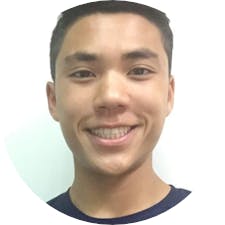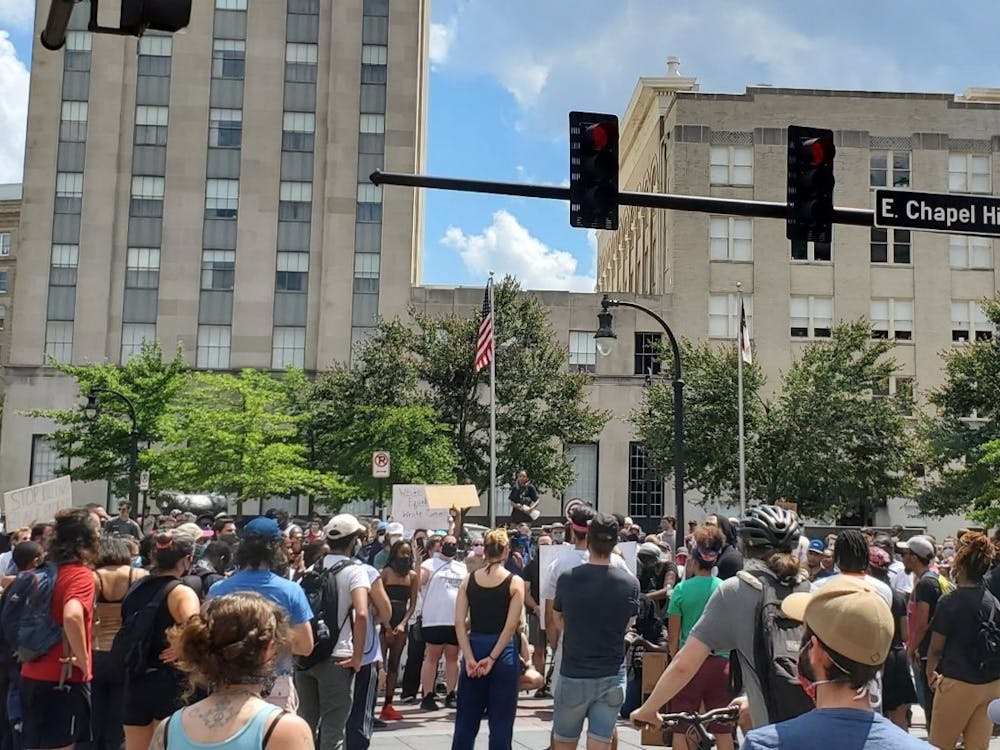The evening of May 30, sophomore Bethlehem Ferede saw tear gas float toward a crowd of protesters in Raleigh. It looked like a cloud of smoke, she said. But smoke wouldn’t account for what came next: the “blood-curdling” screams of people inhaling the gas.
Besieged by the traumatic, the mind retreats to the concrete and the trivial. Ferede distinctly remembers someone at the protest walking around yelling, “I found someone’s yellow iPhone. Whose iPhone is this?” after the chemical fog spread.
“And I think that was a microcosm of, like, how chaotic it really was,” Ferede said.
Protests against racism and police brutality flooded the country after the May 25 killing of George Floyd, and Duke students joined in. They made signs, led chants, spoke and ran from tear gas.
Ferede attended two protests: the one in Raleigh, and one in Durham June 13. Thousands came for the Raleigh event, which started off peacefully around 5 p.m., she said.
But later that evening, Raleigh police fired the tear gas. Ferede and her sister stayed until nine in the evening. By that time, flashing lights from police cars punctuated the darkness along every street.
“You could just feel it getting more and more tense over time,” she said. “A lot of it had to do with the increased police presence.”
The Durham protest had a much different feel, Ferede said. It was much smaller and less tense, with a focus on advocating for the removal of school resource officers from the Durham public school system.
At the event, Ferede shared a speech drawing on her own experiences in the Durham school system and emphasizing the solidarity between Durham activists and Duke student protesters.
“I think there's oftentimes a very kind of odd divide between Duke organizing and Durham organizing, which is very, very dangerous and counterproductive,” she said.
Making a public stance against school resource officers felt both scary and liberating, Ferede said: frightening because of the loss of privacy, but freeing because, despite the odds and opposition, she had found a way to express herself.
The event also included poetry reading. One poem in particular stood out to Ferede. The author described how she felt her childhood had been stripped away because of her race and gender. “And how complicated it was to be fighting against this system that essentially stole her childhood away from her,” Ferede said.
Sophomore Lily Levin was in Raleigh that day as well. She, alongside thousands more, started at the city courthouse and marched to the city jail, chanting, “No justice, no peace. No racist police.” The protesters also blocked Capital Boulevard, a major Raleigh highway, closing a section of the highway.
Levin said she stood at the front of the crowd but remembers police officers shooting tear gas at the back of the protest around 7 p.m. Later, some people damaged downtown buildings and looted businesses.
The goal of protests is to bring about change by shedding light on issues like police abolition, Levin said. Rioting can also be an effective political strategy, she said.
“Honestly, I just really don’t understand the non-Black people who are criticizing rioting and looting,” she said. “It’s such a valid way to show anger, but it also gets things done… It’s the language of people who haven’t been heard.”
When junior Catherine McMillan drove to Ardrey Kell High School, her former high school in Charlotte, it was only the second time she had stepped inside a car to leave her house since March.
McMillan was headed to a community-organized event to repaint a rock at her school. The rock had originally been painted with Black Lives Matter messages, but it had recently been defaced. Someone had used red paint to cross out messages that read, “I can’t breathe” and “End police brutality.” They had also used blue paint to cover the rock with the word “lies.”
Dressed in black, McMillan brought masks, water and a handmade sign that read, “All lives can’t matter until Black lives matter.” At the school, she and the hundreds of other current and former students queued in four lines at the rock. Mcmillan waited in line for seven minutes before dipping her gloved hand in blue paint and pressing her hand on to the rock.
In another part of the event, she and the other students gathered with their signs in a grassy area at the school. McMillan said she was surprised by the amount of activism that has taken place in Ballantyne, an affluent, heavily White neighborhood in south Charlotte.
“The fact that Ballantyne is seeing a lot of protests, it really gives me hope that we’re beginning to open our eyes and see what’s around us,” she said. “When you’re in a position of privilege, sometimes it’s easy to ignore that which you don’t have to experience.”
She emphasized that the repainting of the rock, though small in scope, carries an important message.
“I think us coming together as a community showed whoever was responsible for defacing the rock that we are powerful, we are stronger, and we can surmount these ideas that are quite poisonous to social advancement,” she said. “Even though we’re just painting a rock, even though I just dipped my hand in some paint, I know that I’m part of something bigger.”
The rock’s defacement also shows the reality of ongoing resistance to the Black Lives Matter movement, she said.
“It’s not over yet, and that’s evidenced by the fact that the rock was scrawled over with ‘Blue Lives Matter.’ It’s definitely not over. There’s still more work to be done, which is why the protests will continue. And they will until change is won.”
Senior Jamal Burns grew up during Black Lives Matter protests. He was around five or six when his father told him about the Rodney King riots; Burns, who is Black, remembers his school in St. Louis being cancelled for a week because of protests after Michael Brown’s death.
On June 7, Burns participated in a protest in St. Louis. 5,000 people had RSVP’d for the event on Facebook. Around 2 p.m., the group started at the city hall and marched to the police department headquarters.
The day was “hot as hell,” up to 90 degrees Fahrenheit. Burns wore khakis and a white shirt emblazoned with the word “Relevant.” As the group marched through the city, Burns helped lead chants for the middle section of the protesters: “Who are we? Breonna Taylor” and “No more pain for Tony McDade,” among others.
The protest was peaceful, with very little confrontation between protesters and police. Burns worried less about tear gas and more about the threat of COVID-19.
“Coronavirus is a plague, and it's a plague that disproportionately affects Black and Brown people,” Burns said. “It’s something that I was really cognizant of because most of the people marching were obviously Black and Brown. And so it’s like, we’re all here in this space, but we have to remember the fact that the healthcare system is not systematically designed to support individuals like this.”
Everyone who attended the march was required to wear a mask, Burns said. He kept people from touching hands, encouraging them to hit elbows instead. Six feet apart is a tough standard for a protest, but Burns tried to keep people at a “respectable distance.”
But there was much more than the coronavirus on his mind that day. The past weighed heavily on Burns, who is a history major.
“We are really situating ourselves in a historical moment. But the historical moment is not 2020,” he said. “It goes back to 1992. It goes back to 1965. It goes way further back than we think.”
Because each of us lives for a finite period, it’s easy to lose sight of what’s come before, he said. But, for the Black community, a protest is an act of solidarity with the activism of the past. Rebellion is in our “genealogical tree, in our blood,” he said.
“While I agree with a revolutionary mindset, it's like this is a part of a revolution that has been happening for so much longer than we have, and I think that taking your ego out of it sometimes is important. And just realizing this is a long historical struggle, and now you get to be a part of that struggle and you can make a decision to be a positive or negative influence.”
Dwelling on the past also forces a person to grapple with the future. During the protest, Burns saw a child sitting in a wagon. The kid was very young, barely able to walk, and he held a cardboard sign that his parents must have written for him. It read: “Am I next?”
Seeing such things motivates him to keep fighting, Burns said.
“You have to realize that there was a ‘before you’ and there’s an ‘after you.’ We can make a legitimate change if we continue to fight,” Burns said. “And I think, you know, it's very optimistic. And I get that, but I think you have to err on the side of optimism, because optimism is a tool against White supremacy.”
Correction: An earlier version of this article incorrectly quoted Burns as saying coronavirus "unfortunately" affects Black and Brown people. It has been updated to reflect that he said it "disproportionately" affects them. The Chronicle regrets the error.
Get The Chronicle straight to your inbox
Signup for our weekly newsletter. Cancel at any time.

Chris Kuo is a Trinity senior and a staff reporter for The Chronicle's 118th volume. He was previously enterprise editor for Volume 117.

